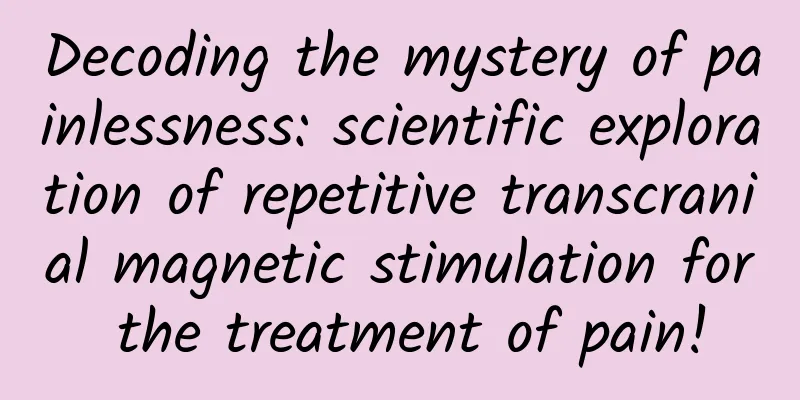Decoding the mystery of painlessness: scientific exploration of repetitive transcranial magnetic stimulation for the treatment of pain!

|
“What is repetitive transcranial magnetic stimulation therapy?” “Can pain really be improved without medication or injections?” “What should I do if I am anxious, depressed and always in a bad mood? Today we will take you to find out. In the long history of medicine, pain has always been a companion that humans cannot get rid of. Whether it is acute trauma or chronic disease, pain can always invade our lives inadvertently. With the advancement of technology, a new treatment method called repetitive transcranial magnetic stimulation (rTMS) is gradually becoming a ray of hope for pain relief. Today, let us step into the world of this technology and unveil its mysterious veil. 01Neural Mechanism of Pain To understand how rTMS works, we first need to understand how pain is generated in the brain. When a part of our body is injured, nerve endings in the damaged area send signals to the spinal cord, which are then transmitted to the cerebral cortex through a complex neural network. Here, the pain signals are sensed, processed, and transformed into unpleasant sensations that we can experience. 02Understanding rTMS rTMS is a non-invasive neuromodulation technology that uses powerful magnetic field pulses to act on specific areas of the scalp surface, thereby affecting brain activity below. These magnetic field pulses can penetrate the skull and stimulate or inhibit neurons in the cerebral cortex, thereby changing its functional state. Motor evoked potentials, changes in EEG activity, cerebral blood flow, metabolism, and changes in brain functional state can be detected, and its microscopic effects include changes in cell membrane potential, action potential, neurotransmitters, receptors, synapses, and neuroplasticity. 0 How 3rTMS treats pain Studies have shown that abnormal activity in certain areas of the brain is closely related to the occurrence and development of chronic pain. By precisely targeting these areas, rTMS can adjust the excitability of neurons, reduce overactive signal transmission, or enhance the ability to process pain signals, thereby achieving the purpose of relieving pain. l Regulate the excitability of the cerebral cortex. Neuralgia often causes abnormal excitability of the central nervous system. Studies have shown that high frequencies can increase the excitability of the local cerebral cortex, while low frequencies have the opposite effect. l Affects local blood flow in the brain. NP is often accompanied by a relative decrease in blood perfusion in the brain (thalamus). Low frequency can affect cerebral blood flow velocity, while the contralateral side has a compensatory increase. l Improve neurotransmitter levels. There are many chemicals in the human body that are closely related to pain relief. For example, brain-derived neurotrophic factor, as one of the neuronal regulators, has an important impact on neuronal plasticity and the relief of chronic pain. l High-frequency rTMS inhibits the proliferation and activity of glial cells, thereby reducing pain, while low-frequency rTMS has no obvious effect. l Activate inhibitory circuits associated with pain relief. In functional magnetic resonance imaging, prefrontal stimulation can regulate the excitability of pain circuits and induce analgesic effects. 0 4 Treatment process and effect To receive rTMS treatment, the patient sits in a comfortable chair while the doctor places a device with a coil on the patient's head. Currently, the stimulation targets of rTMS for the treatment of neuropathic pain are mainly the primary motor cortex (M1 area) and the dorsolateral prefrontal cortex (DLPFC). Regardless of which target is stimulated, the resting motor threshold (RMT) must be determined before using rTMS. A single TMS pulse stimulates the primary motor cortex on one side, and motor evoked potentials are recorded using surface electrodes at the first dorsal interosseous muscle of the hand on the contralateral side of the stimulation. The RMT is defined as the lowest stimulation intensity that evokes a motor evoked potential of at least 50 μV in 5 of 10 consecutive trials. The stimulation intensity of rTMS can then be determined based on the RMT. Then, a series of magnetic field pulses from the device kick in. The procedure is usually painless, though the patient may feel a slight tapping sensation or hear a sound similar to the click of a switch. How long does a repetitive transcranial magnetic stimulation ( rTMS ) session take ? The onset time varies greatly depending on the disease, combined medication and individual differences. Generally speaking, repetitive transcranial magnetic stimulation (rTMS) treatment is once a day, 5 days a week, and a course of treatment is 2 to 3 weeks. According to clinical studies and literature reports, the efficacy of repetitive transcranial magnetic stimulation can last up to 6 to 12 months. Currently, rTMS has been used to treat many types of pain, including migraine, neuropathic pain, and fibromyalgia. Although each patient's response is different, many studies have shown that rTMS can relieve pain to a certain extent and improve the patient's quality of life. 0 5 Security and Outlook As a non-drug treatment, rTMS is relatively safe with few side effects, most commonly transient local discomfort or headache. However, since it involves direct intervention in brain activity, the treatment must be conducted under the guidance of professional medical personnel. Conclusion: Repetitive transcranial magnetic stimulation technology is like a delicate dancer, jumping on the stage of the brain, adjusting the rhythm of the nerves with precise movements, bringing new hope to those who suffer from pain. Author: Zang Yaning, Department of Rehabilitation Medicine, Chengdu Second People's Hospital Reviewer: Zhu Yi, The Fifth Affiliated Hospital of Zhengzhou University Photo: Wu Xiuxiang, Second Affiliated Hospital of Hainan Medical College Editor: Zhu Xiaoqing Xinhua Hospital Affiliated to Shanghai Jiaotong University School of Medicine |
<<: When can I eat after surgery?
>>: To help you with the college entrance examination, you need to pay attention to your diet
Recommend
How long can I have an abortion during early pregnancy?
The contemporary social work market is highly com...
How long after weaning can I massage my breasts for breast enhancement?
Women all love beauty very much, so they should n...
What is the situation when female vaginal discharge has an odor?
We all know that whether a woman's vaginal se...
Why does the leucorrhea after abortion look like tofu dregs?
Nowadays, people's ideas are becoming more an...
What is the importance of women's sexual health?
Women are a relatively vulnerable group, and they...
Why wear makeup? You'll know it's necessary.
In today's society, people's material lif...
If my period comes on the 23rd, which day is the ovulation period?
For women, especially those who are preparing for...
Why do girls have neck pain?
In daily life, we encounter various troubles and ...
White fluid in the vagina Vaginal mucus
Many people have only a vague understanding of va...
What should I do if wounds proliferate?
Caesarean section is a very common method of deli...
Nielsen: Super Bowl overtime draws more than 100 million U.S. viewers
199IT original compilation According to the lates...
Ovulation calculator
If the menstrual cycle is irregular, the time of ...
Does vasectomy affect women's sexual function?
Sterilization is a common contraceptive method in...
How to enlarge breasts for girls
Many young girls want to make their breasts bigge...









